Let us share with you the submissions from the students and teachers who participated in the Black-faced Spoonbill Youth Conservation Activity, which was held in Incheon, Republic of Korea, last year. These are based on their continuous monitoring activities.
The Story of K94, ‘Gusailsaeng’
Written by Park Young Ran, Teacher Goo Jeolcho
Data by Kim Hyeong Moon, Teacher Pureunsup (Green forest)
23 June 2015
A Black-faced Spoonbill with the ring K94 tells us a special story to the people monitoring birds at Namdong Reservoir, Incheon.
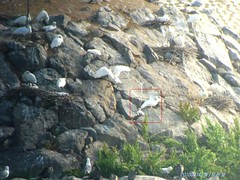
The young Black-faced Spoonbill being attacked
Already five years ago, at 5 p.m. on June 14, 2010
Monitoring spoonbills at Namdong Reservoir, Teacher Pureunsup found a young spoonbill laying on the rocks.
‘How come this baby bird left its nest?’ wondered the teacher when a Herring Gull flew in and started pecking the baby. An adult spoonbill flew in to join the Herring Gull and they started to threaten him. When the herring gull started to attack again, the helpless baby fell to the lower part of the rocky island.
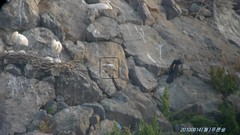
Young Black-faced Spoonbill returning to its nest
However, the presumably dead baby bird, somehow found strength to get back up and started to clamber up the rocks step by step.
When it slipped, he climbed again. The bird walked with faltering steps struggling to balance on its yet small wings. Finally, after thirty minutes, the young bird managed to return to his nest where it reunited with his parents and siblings.
Everyone who heard this story applauded with excitement praying for the young bird’s future.
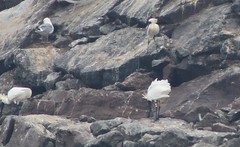
K94 returning home for breeding
That year, we were ringing birds and the young bird got a ring with the number 94. People thought it was destiny and they gave him the nickname ‘Gusailsaeng (K94),’ which means ‘a narrow escape’ in Korean.
Was it thanks to the name?
In 2013, K94 returned to his hometown, Namdong Reservoir, in a good shape. In 2014, he tried to breed but failed as his nest was flooded.
Will K94 become a father when he returns to Namdong Reservoir this year?
Epilogue
K94, ‘Gusailsaeng,’ found a place at the bottom of the island for breeding but failed. However, he had the eggs at the same place and incubated them. While raising the babies, he luckily didn’t rain so the nest wasn’t flooded. Thanks to the drought, he raised two babies successfully.
I hope K94 settles on the upper part of the island next year, but I can’t know what his plans are.
A Story of Chungchung, Namdong Reservoir’s Local Fixture
Written by Sung-jeong Nam
Translated by Sungpil Um (Songdo High School)
Photos and data by Kisup Lee, Black-faced Spoonbill Conservation Network

The colour combination of its tags tells us K67 is a female born in 2007 in Incheon
Black-faced Spoonbills have been breeding at Namdong Reservoir since 2009. Since then, many spoonbills have come to the artificial island at Namdong Reservoir, but still not many people recognize individual spoonbills. Fortunately, spoonbill experts attached colour bands to their legs which allow us to identify them now.
A colour band has one longer ring closed around the bird’s leg that has a combination of letters and digits. For the other leg, a smaller ring of a different colour is attached. Each country has a different colour code for their longer ring. Red is used by Korea, blue is for Taiwan, yellow for Japan and Hong Kong uses green. The letter represents the country K – Korea, J – Japan, T – Taiwan, and A – Hong Kong. The colours of the rings show the birth year of the spoonbill, the location of its wintering ground, and its migratory route.
 |
 |
 |
 |
Among the spoonbills with rings, the oldest one that breeds at Namdong Reservoir is called ‘Chungchung.’ It has two short blue rings attached to its left leg. The long ring was red, but it got lost. It could have been damaged or came off because it is made of plastic.
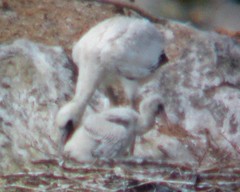
Chungchung looking after two babies in 2010
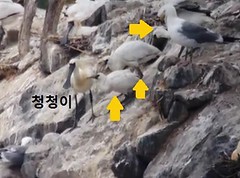
Chungchung with three babies in 2014
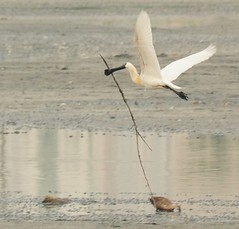
Chungchung holding a twig 2011
Visiting Namdong Reservoir since 2009, it has been seen attempting to breed every year since 2010. It is a hard-working male that makes his nest with lots of love, incubates his eggs, and raises his babies every year.
I wonder when it will come again and how long it will be able to raise babies for. I wish Chungchung a long healthy life with many babies.
Come with me – the story of E37
Written by Teacher Gujeolcho
Translated by Siheong Lee (Songdo High School)
Photos, data by Black-faced Spoonbill Conservation Network, Kisup Lee
23 June 2015
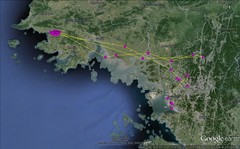
Migratory route of E37 across the west coast of Korean peninsula, China and Taiwan
1 July 2011, E37
I was born in Gakssiam in Ganghwa in 2011
One day, people came to our island
Friends quickly ran away
But I was caught by them
People put a tracker on my back
It was heavy and uncomfortable at first
I wanted to take it off
Now I am used to it like it is part of my body.

The travel route in 2014: from North Korea to Namdong Reservoir
I like adventures
l would like to visit many places
I was born in Gakssiam
But what do islands in Ongjin look like?
Is there any food in the south?
Are there any places to live in the north?
l went around up and down along the west coast.
Winter? Of course it’s cold
There is no food in winter
I went down to the south
Crossing the west coast of Korean peninsula and going south along the Chinese coast, I spent the winter in the south of Taiwan’s west coast in mud flats and fish farms
In 2014, I flew around Ongjin peninsula, Dongducheon, Han river in the north to find food and a breeding place
I heard rumours about a large heard of black-faced spoonbills
I came to Namdong reservoir.
As they say, there live many black-faced spoonbills
I hit the road trying to find an appropriate place to have and raise my babies
Now I need to settle here
I worry if I will be able to lay eggs and take good care of my babies among many other black-faced spoonbills. Please keep your fingers crossed for me.
The Story of ‘Norangi’ who Almost Died with Her Feet Bound by Plastic Strings
Written by Mi-ri Lee
Translated by Sung-pil Um
Photos & data by Namjun Ji, Kisup Lee, Yonggil Jo, Sun Jeong Nam,
and Walter (Hong Kong Bird Watching Society)
Black-faced Spoonbill parents would normally make a nest with branches or grass and put feathers or soft grass under the eggs. However, many spoonbills use plastic bags that are easy to found at the reservoir.
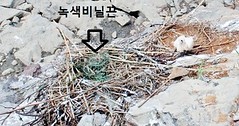
Nest filled with plastic strings
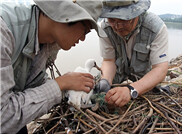
Researchers rescuing the bird
In 2011, we found a 15-day-old spoonbill stuck in the nest made of green plastic strings. It couldn’t move with the feet tangled in plastic strings. Researchers who went to the artificial island rescued this bird.
We brought it immediately to the animal hospital. When we untangled the plastic strings, the toe looked infected. Although the spoonbill was limping, we decided to let it go back to the island hoping that it would overcome the pain and we hoped the bird could walk again.
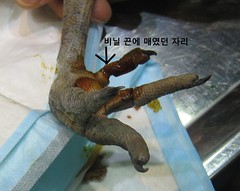
Foot of young BFS

Strings removed from BFS
We also attached a yellow ring to the other leg. This allows us to monitor whether the bird stays healthy. We call it ‘Norangi’ since then.
Norangi has grown well. It came to the place where we were monitoring and let us know it was okay. We saw it fly to the Sihwa Lake and feed alongside its parents.
Plastic bags, strings, fishing lines, and nets which we thoughtlessly throw out can take birds’ lives. I hope this story inspires you to reflect on our careless actions that may have caused harm to wildlife. Now, Norangi in a grown-up and comes to Namdong Reservoir every spring after wintering in Hong Kong. In 2015 she built a nest, laid and incubated eggs. However, she failed to be a mother because of a flash flood. Let’s hope that Norangi has pretty babies next year.

18 August 2011 Namdong reservoir
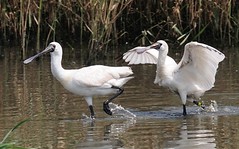
4 September 2011 Sihwa lake

11 February 2012 Maipo Hongkong
Proofread by EAAFP Secretariat




